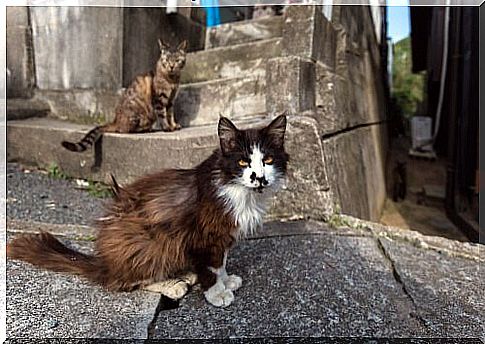The Cat Islands In Japan

Off the coast of Japan there are some islands with many more cats than human inhabitants: they are called cat islands. They are very popular tourist destinations, but they may not be as happy as they first appear. We invite you to visit Aoshima, one of the cat islands in Japan.
Where are the cat islands?
Aoshima is one of the best known cat islands in Japan. There are only 15 people on it and, in contrast, the cats number more than 100. This island is located in Ehime province , in the south of the country.
Another of the best known cat islands is Tashirojima, which receives around 10,000 visitors a year. It is located in Miyagi Prefecture, in the north of the country and much closer to the coast than Aoshima.
In both cases, it is necessary to travel by boat from the main island of Japan. Trips depend on many factors, but both trips take approximately half an hour. Hours vary according to seasons and visitor flow, but are generally limited to a few daily tours.
How the island came to have so many cats
The biggest attraction of these places is the huge abundance of cats that live in them. In the case of Aoshima, it is estimated that there are six cats per inhabitant. These animals, which depend on humans for food, no longer find enough prey to hunt on their own, they are very docile and friendly.
They are used to the presence of strangers on the island, thanks to the influx of tourists. They know how to pose for photographs and are friendly to visitors. Therefore, they are not like the usual stray cats that we find in other parts of the world.

Visitors to these places find a postcard that is hard to find anywhere else in the world: hundreds of friendly cats that are easily photographed and that, in addition, ask to interact with people.
Cat Islands face a difficult dilemma to resolve: the excessive presence of tourists, who feed the cats. This allowed the feline population of these locations to grow uncontrollably. However, tourists do not leave economic or human resources to keep this population healthy, sterilized and well fed.
Caregivers on the cat islands
As many of the people who visit these places claim, many of these cats are affected by common and easily treatable diseases. The most frequent are respiratory and eye infections, although there are wounds, skin problems and many other problems arising from these.
Also, no one is responsible for neutering the cats that live on the islands, so litters continue to be born continuously and the feline population continues to increase.
For some years now, groups of volunteers, who do not reside on the islands, have come to them to treat the animals and also launched the modest CES project (Capture, Sterilization and Release). Despite their efforts, the economic capacity is not enough to supply all the cats that live in these places.

When asked by a magazine, which was reporting on how to improve the quality of life of these cats, one of the visitors to these places stated:
The impact of tourism
In fact, on these islands, the presence of foreigners who brought in food allowed cat populations to grow into another tourist attraction. The more people visit the island, the more food available to the cats, so they continue to breed.
However, the presence of people on the cat’s islands does not guarantee the health of these animals, the hygienic control of the places where they live, nor veterinary care. It’s a vicious circle in which, if tourism disappears, cats will no longer have food, but if tourism is not controlled, cats will continue to multiply.
Aoshima and Tashirojima aren’t the only places where this happens: more than a dozen islands are in the same situation, just in Japan. There are other tourist destinations where populations of monkeys or seagulls, for example, have gotten out of control thanks to the abundance of food.
Tourists visiting these destinations should be aware of the impact their presence has anywhere in the world. It is possible to carry out responsible and ecological tourism, enjoy the wonders of flora and fauna on our planet without negatively affecting certain locations.








